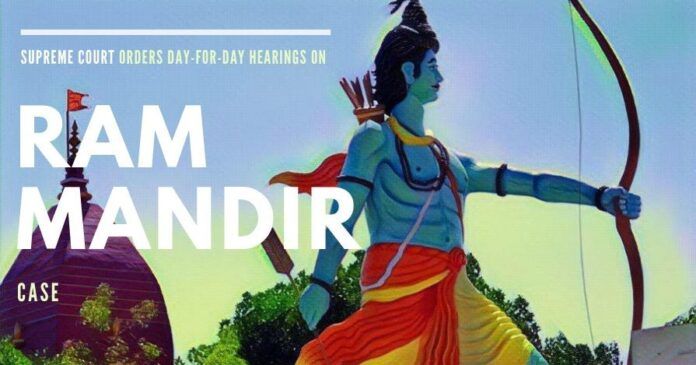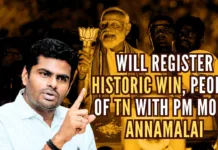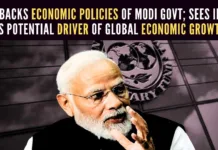
After the destruction of the Ram Mandir in Ayodhya around 500 years ago and 134-year-old litigation started in 1885, the Supreme Court of India on Friday decided to conduct a day-to-day hearing in the case, after finding the failure of the last mediation attempt. It is widely believed that the judgment is expected to come any time before November 17, as the lead Judge, Chief Justice Ranjan Gogoi retires on that day.
From October 2010, the appeal against the Allahabad High Court verdict on Ayodhya case is pending before the Supreme Court and it is a known fact that the apex court’s many Chief Justices were shy on touching this politically sensitive case. It is well known that the Congress-led United Progressive Alliance (UPA) regime till mid-2014 was playing all types of frauds to put this case in the deep freezer. The case got momentum after the joint press conference of the then Vishwa Hindu Parishad (VHP) President Ashok Singhal and the Bharatiya Janata Party (BJP) leader Subramanian Swamy on September 30, 2015, at the Vishwa Hindu Parishad (VHP) office in Delhi. In that press conference, Ashok Singhal authorised Subramanian Swamy to lead the case and also convened a conclave on how to go revive the case, which is pending in the apex court[1].
After the bench on Friday passed the order, senior advocate Rajeev Dhawan, appearing for the Sunnis raised several technical issues and said he will need 20 days to argue the various issues arising in the matter in detail and there should not be any curtailment on the hearing.
By early 2016, Swamy approached the Supreme Court with a petition seeking basic facilities for pilgrims who visit the current makeshift temple in Ayodhya. In his petition, he pointed out the pathetic state of the idol – Ram Lala – and the plight of the pilgrims who have no basic facilities. The notices were issued to Centre and the Uttar Pradesh Government and Swamy then soon come out with a new petition seeking the right to pray as his fundamental right. The Supreme Court Bench that handled this petition directed this petition to be tagged with the appeals on the main case, pending from 2010.
At last the Supreme Court listed the case on March 2017 and then Congress, Left, and the Sunni Board’s advocates started creating all kinds of tantrums to delay the case. Former Chief Justice Dipak Misra, who tried to speed up the arguments, faced Impeachment threats from Congress and Left parties.
The detailed timeline of the Ayodhya case from 1528 is detailed below this article.
“We have received the report submitted by Justice (Retd) F M I Kalifulla, the Chairman of the Mediation Committee. We have perused the same. The mediation proceedings have not resulted in any final settlement. We, therefore, have to proceed with the hearing of the cases/appeals, which will commence on and from August 6 (Tuesday),” said a 5-judge bench headed by Chief Justice Ranjan Gogoi.
“The hearing which will be on a day-to-day basis until the arguments are concluded will start with the appeals arising out of the two suits. The learned counsel(s)…In the appeals arising out of the aforesaid suits may, for the convenience of the court, indicate the pleadings and the evidence on which they propose to rely, so that the officials of the Registry can keep the said documents ready for perusal of the court,” ordered the bench also comprising Justices S A Bobde, D Y Chandrachud, Ashok Bhushan and S A Nazeer.
After the bench on Friday passed the order, senior advocate Rajeev Dhawan, appearing for the Sunnis raised several technical issues and said he will need 20 days to argue the various issues arising in the matter in detail and there should not be any curtailment on the hearing. For the past three years, Dhawan has been throwing tantrums (earlier with Kapil Sibal) to delay the case. While he was raising different aspects of the matter and how the appeals have to be heard, the bench told him “don’t remind us what we have to do”.
“We know there are many aspects and we will deal with all these aspects. Let the hearing start,” Judges reminded Dhawan. Dhawan also raised the issue of a pending writ petition filed by BJP leader Subramanian Swamy. The Judges rejected Dhawan’s demand and said that they will first hear the arguments in the main case and then proceed to the hearing of Swamy’s case on fundamental right to pray.
Fourteen appeals have been filed in the apex court against the 2010 Allahabad High Court judgment, delivered in four civil suits, that the 2.77-acre land in Ayodhya be partitioned equally among the three parties — the Sunni Waqf Board, the Nirmohi Akhara and Ram Lalla.
The detailed chronology Ayodhya is presented below:
1528: Ram Mandir was demolished by Mughals and Babri Masjid built over the temple by Mir Baqi, commander of Mughal emperor Babur. Mir Baqi was a Shia and for a long time, Shias were controlling the disputed Mosque.
1885: Mahant Raghubir Das files plea in Faizabad district court seeking permission to build a canopy outside the disputed Ram Janmabhoomi-Babri Masjid structure. The court rejects the plea.
December 6, 1949: Idols of Ram Lalla placed under a central dome outside the disputed structure by a Hindu mob.
1950: Gopal Simla Visharad files suit in Faizabad district court for rights to worship the idols of Ram Lalla. – Paramahansa Ramachandra Das also files suit for the continuation of worship and keeping the idols.
1959: Nirmohi Akhara files suit seeking possession of the site.
1981: UP Sunni Central Waqf Board files suit for possession of the site, claiming they got possession from the British Government as Shias are not serious about the administration of the Mosque. Shias always objected to the Sunnis for capturing their property. Many a time the Shias declared their intention to hand over the area to Hindus to re-construct Ram Mandir after Independence in 1947.
Feb 1, 1986: Local court orders the government to open the site for Hindu worshippers.
Aug 14, 1989: Allahabad HC ordered maintenance of status quo in respect of the disputed structure – but allowed prayers in the temple to continue.
Dec 6, 1992: Babri Masjid structure demolished in a mass movement led by BJP, Shiv Sena and Sangh Parivar.
Apr 3, 1993: ‘Acquisition of Certain Area at Ayodhya Act’ passed for acquiring land by Centre in the disputed area. – Various writ petitions, including one by Ismail Faruqui, filed in Allahabad High Court (HC) challenging various aspects of the Act. SC exercising its jurisdiction under Article 139A transferred the writ petitions, which were pending in the High Court.
September 14, 1994: PV Narasimha Rao Government files an affidavit in Supreme Court that the disputed area will be handed back to Hindus if it is proved that a Masjid was built over Ram Mandir and Ordered probe to be conducted by the Archaeological Survey of India.
Oct 24, 1994: SC says in the historic Ismail Faruqui case that the mosque was not integral to Islam.
Apr 2002: HC begins hearings on determining who owns the disputed site.
Mar 13, 2003: SC says, in the Aslam alias Bhure case, no religious activity of any nature is allowed at the acquired land.
In mid-2003 – the Archaeological Survey of India submits reports to Government about the existence of a Temple and said that 14 temple pillars were found below the Mosque.
Sep 30, 2010: Allahabad HC, in a 2:1 majority, rules a three-way division of disputed area between Sunni Waqf Board, the Nirmohi Akhara and Ram Lalla and by October 2010, all parties filed an appeal in Supreme Court against the HC verdict.
May 9, 2011: SC stays HC verdict on Ayodhya land dispute.
Mar 21, 2017: CJI JS Khehar suggests an out-of-court settlement among rival parties.
Aug 7, 2017: SC constitutes a three-judge bench to hear pleas challenging 1994 verdict of the Allahabad HC.
Feb 8, 2018: SC starts hearing the civil appeals and in Oct 29, SC fixes the case for the first week of January 2019 before an appropriate bench, which will decide the schedule of hearing.
Jan 8, 2019: SC sets up a five-judge Constitution Bench to hear the case headed by Chief Justice Ranjan Gogoi and comprising Justices S A Bobde, N V Ramana, U U Lalit, and D Y Chandrachud. On Jan 10, Justice U U Lalit recuses himself prompting SC to reschedule the hearing for January 29 before a new bench.
Jan 25, 2019: SC reconstitutes 5-member Constitution Bench to hear the case. The new bench comprises Chief Justice Ranjan Gogoi and Justices S A Bobde, D Y Chandrachud, Ashok Bhushan and S A Nazeer.
Jan 29, 2019: Centre moves SC seeking permission to return the 67-acre acquired land around the disputed site to original owners.
Feb 26, 2019: SC favours mediation, fixes Mar 5 for order on whether to refer the matter to a court-appointed mediator.
Mar 8, 2019: SC refers the dispute for mediation by a panel headed by former apex court judge F M I Kallifulla.
Apr 9, 2019: Nirmohi Akhara opposes in SC Centre’s plea to return acquired land around Ayodhya site to owners.
May 9, 2019: A 3-member mediation committee submits an interim report in SC.
May 10, 2019: SC extends the time till Aug 15 to complete the mediation process.
Jul 11, 2019: SC seeks a report on “progress of mediation”. On Jul 15, the Special Judge seeks 6 more months from the SC to conclude trial involving L K Advani, M M Joshi, Uma Bharti, and others. On Jul 18, SC allows the mediation process to continue, seeks outcome report by Aug 1.
Jul 19, 2019: SC asks Special judge to deliver verdict in 9 months.
Aug 1, 2019: Report of mediation submitted in a sealed cover to SC.
Aug 2, 2019: SC decides to conduct day-to-day hearing from Aug 6 as mediation fails.
References:
[1] Joint press statement of Shri. Ashok Singhal and Dr. Swamy on Ram temple – Oct 6, 2015, Hindu Janajagruti Samiti
- Elon Musk postpones India visit. Non-clarity in Tesla partner and Starlink license might be the reasons - April 20, 2024
- NIA confiscates Pak-harboured Khalistani terrorist Lakhbir Singh Rode’s key aide’s land in Moga - April 19, 2024
- Prime Minister Narendra Modi: A Gujju businessman who does not invest his precious time for a losing battle - April 13, 2024











[…] अक्टूबर 2010 से, अयोध्या मामले पर इलाहाबाद उच्च न्यायालय के फैसले के खिलाफ अपील उच्चतम न्यायालय के समक्ष लंबित है और यह ज्ञात तथ्य है कि शीर्ष अदालत के कई मुख्य न्यायाधीश इस राजनीतिक रूप से संवेदनशील मामले को छूने से कतराते रहे। यह सर्वविदित है कि 2014 के मध्य तक कांग्रेस के नेतृत्व वाली संयुक्त प्रगतिशील गठबंधन (यूपीए) सरकार ने इस मामले को ठंडे बस्ते में डालने के लिए सभी प्रकार के हथकंडे अपनाए गए। 30 सितंबर, 2015 को विश्व हिंदू परिषद (वीएचपी) के दिल्ली स्थित कार्यालय में तत्कालीन वीएचपी अध्यक्ष अशोक सिंघल और भारतीय जनता पार्टी (भाजपा) नेता सुब्रमण्यम स्वामी की संयुक्त प्रेस कॉन्फ्रेंस के बाद मामले को गति मिली। उस प्रेस कॉन्फ्रेंस में, अशोक सिंघल ने सुब्रमण्यम स्वामी को इस मामले का नेतृत्व करने के लिए अधिकृत किया और इस मामले को पुनर्जीवित करने के तरीके पर भी विचार-विमर्श किया, जो शीर्ष अदालत में लंबित है।[1]. […]
Supreme court which overnight pronounced shabarimala verdict against Hindus without any rational. Now taking decades together to deliver (100%) a pro Hindu judgement. Bying time in every way. Hope this time planning to take excuse chief justice’s retirement. No temple no BJP next term. How long do we wait for our rights. kindly read novel Avaran by Sri. S. L. Byrappa to understand what we lost and how helpless Hindus were. Shame.
At last…
After many years…
A dream come true for Hindus…
(Provided judges listen to both their mind n heart…)
Atleast by next navami temple construction should begin…
After a very very long wait. JAI SHRIRAM JAI RAM JANMABOOMI.
Jai Shri Ram….Mandir Wahi Banayenge…..Kashi, Mathura Baki Hein….Jai Shri Ram